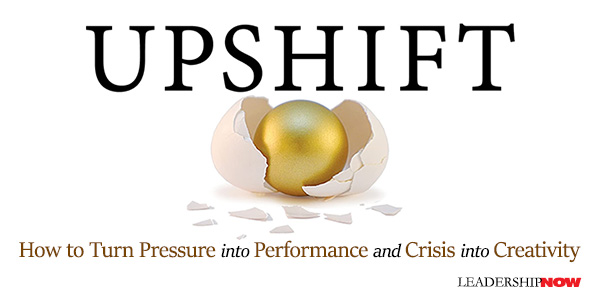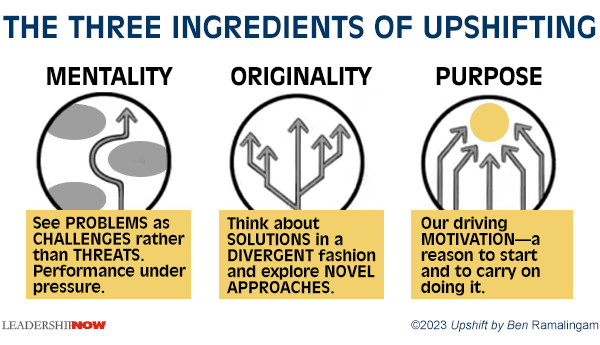 |
 |
02.27.23

Upshift: How to Turn Pressure into Performance and Crisis into Creativity
PROBLEMS come our way. They always do. And too little of the associated stress is not good. We become disengaged, demotivated, and unfulfilled. But with too much stress we become overloaded, and we just feel like shutting down. But in between is the Challenge Zone. International crisis management specialist Ben Ramalingam writes in Upshift: Turning Pressure into Performance and Crisis into Creativity, that between the two extremes is the “sweet spot” where we experience a healthy level of stress. We start to move toward this sweet spot when we switch from perceiving a stressful situation as a challenge rather than a threat. This is where we start to move from the left- or right-hand below-par-performance sides into the peak-performance zone. We click into being at the top of our game: into Upshifting.
Necessity is necessarily the mother of invention. “Evidence and experience suggests that most of the time, the pressure of necessity actually leads us to convention, not invention. When we are under pressure, most of us gravitate towards the safe, the tied and tested.” We actually need three ingredients to capitalize on necessity and turn it into peak performance: Mentality, Originality, and Purpose. When all three are present, we have Upshift. The Upshifting Mentality The upshifting mentality is the switching process. We have all formed over time how we deal with stress. “A threat is a stress that we feel we can not handle, because we do not feel we have the resources to meet the demands of the situation.” How we see a circumstance in our mind determines how we react to it. We have mindsets anchored in beliefs that cause us to see stress as enhancing or debilitating. It is a mental game. It is something that we deliberately learn, practice, and improve on. Exposure to adversity in moderation can develop the mindset we need to cope with future pressure situations and give us an enhanced stress inoculation. We develop this naturally from early on through play-fighting. Original Thinking Under Pressure What we’re looking for here is divergent thinking—the ability to explore multiple possible solutions in order to generate creative ideas. This is opposed to convergent thinking, which is the process of figuring out the most effective answer to a problem. Divergent thinking is more likely “when we appraise a situation as a challenge. Being in a challenge state means we are more willing to explore possibilities.” Purpose A purpose in our lives creates meaning in our circumstances. What we all need is not a tensionless state but, as Viktor Frankl stated, “the call of a potential meaning waiting to be fulfilled by us.” Harvard professor Teresa Amabile “found that in situations where pressure can’t be avoided, you can get people to be creative by instilling a meaningful purpose, where they have a sense that there is an important, urgent need for the work they do. As Amabile puts it, ‘Often we have no choice about being under the gun. But if we want to be creative, we have to learn to dodge the bullets.’” Upshifting is not a given. It is a repeatable set of behaviors that, over time, become engrained habits, ways of thinking and relating, and, ultimately, a way of being. 
Six Upshift Archetypes As Ramalingam points out, “Upshifting builds on our individual and distinctive problem-solving skills and styles.” He has identified six Upshift archetypes, which he discusses in detail, sharing examples of individuals who share those characteristics. They are: Challengers—preferred by those of us who are skilled in constructively disrupting the status quo around us. Social activist Rosa Parks.
Which approach do you habitually turn to? 
Posted by Michael McKinney at 08:06 AM
|
BUILD YOUR KNOWLEDGE
 

How to Do Your Start-Up Right STRAIGHT TALK FOR START-UPS 
Grow Your Leadership Skills NEW AND UPCOMING LEADERSHIP BOOKS 
Leadership Minute BITE-SIZE CONCEPTS YOU CAN CHEW ON 
Classic Leadership Books BOOKS TO READ BEFORE YOU LEAD |